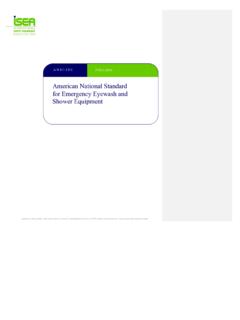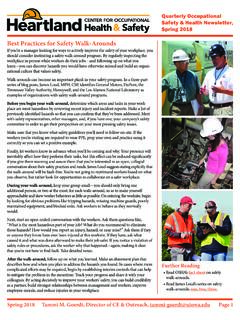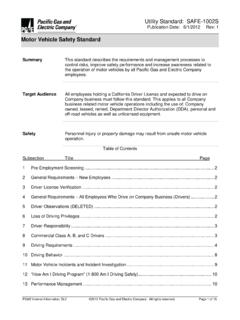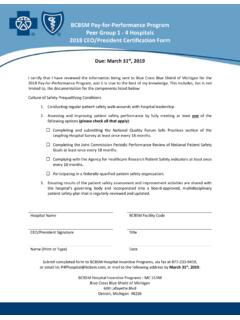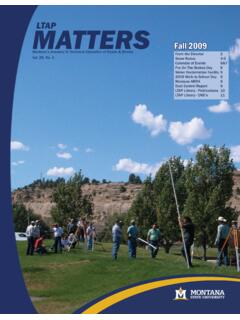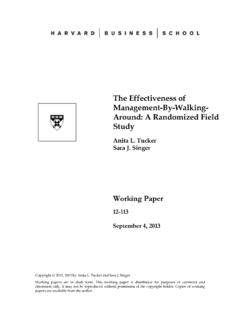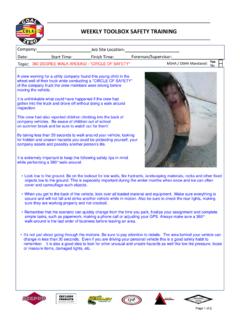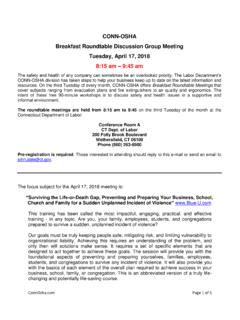Transcription of Making safety habits 081317 - ACS Division of Chemical ...
1 Make safety habits By Finding Your Cues, Routines, and Rewards for SafetyRobert H. Hill, Memorial InstituteAtlanta, GA 30329 Emma June Tillmanns-Skolnik ACS 1942-1984 ICI Americas Research Scientist, Industrial Toxicology, Health & Environmental Affairs CHAS Founding Committee: Councilor, Awards Chair, CCS Liaison Delaware Section: Councilor, Chair (first woman), Secretary Service award: Tillmanns-SkolnikAward Division of Chemical Information: Program Chair, AsstSecretary, Committee on Membership Chair Herman Skonik, Leader; Achievement Award in his nameEye injury from an explosion1 1styear Grad student Making 1 g diazoniumperchlorate Explosion, Serious Injuries Working aloneusing metal spatulaon open bench Wearing ordinary prescription (non- safety ) glasses Explosion shattered glasses, fragments in cornea.
2 Required eye surgery (no permanent damage); lacerations treated1 The safety Zone: More on the UC Berkeley DiazoniumExplosion, Sept 15, 2015; BerkelyEHS Lessons Learned, May 2015; C&EN, Aug 24, 2015 (V93, #33, Injury from Explosion Graduate student not wearing safety glasses Did not follow SOP (signed documentation) Work in hood No metal spatula Not working alone Corrective actions ID hazards, use GHS H codes; ID controls for high risk Use of perchlorates requires PI s written advance approvalSafety Ethics and safety Culture Underlying (Root) Causes Not reported but implied Student lacked safety knowledge; weak safety ethic Systemic Failure -Weak safety culture PI: How do we make safety second nature ? How can we make safety a habit? It s not to the student s benefit if we restrict hypothesis-and curiosity-driven research.)
3 But we have to change the culture so that it s second nature to always put on safety glasses and other PPE and to check the SOPs. Grad Student s PIThe Power of Habit: Why we do what we do in life and business. Charles DuhiggCUEROUTINEREWARDTHE HABIT LOOPThe Habit Loop Most choices we make are not decisions but habits . Duke study: >40% of actions are habits (not decisions) Brain wants to reduce effort: Encodes habits Seeks to make any routine a habit, so it can ramp down Brain s dependence on automatic routines can be dangerous Does not recognize habits as good or bad habits : More automatic with time; Never disappear, but can be ignored, changed, or replacedTHE HABIT LOOP Habit loop: 3 steps CUE OR TRIGGER ROUTINE OR ACTION REWARD Cues: visual; thoughts sequences; emotion Routines: complex or simple Rewards: physical or emotional sensationsCue: Time for breakRoutine: Go to caf for snackReward: Food, drink, chatsCreating or Changing habits Creating new habits Create a craving, need for new habit (neurological) Find simple, obvious cue Clearly define reward(s) Changing old habits Don t change cue or reward Find alternate routine Must believe change will make a difference (believing critical) Does not mean this is easy.
4 Requires determinationYo u r b e l i e f s b e c o m e y o u r t h o u g h t s ,Yo u r t h o u g h t s b e c o m e y o u r w o r d s ,Yo u r w o r d s b e c o m e y o u r a c t i o n s ,Yo u r a c t i o n s b e c o m e y o u r h a b i t s ,Yo u r h a b i t s b e c o m e y o u r v a l u e s ,Yo u r v a l u e s b e c o m e y o u r d e s t i n GandhiMAKING safety A HABIT Te a c h i n g L a b s -Rules CUE: Entry to lab ROUTINE: Wearing safety eyeware, closed toed shoes, no shorts, no short skirts, no mid-drifts, tied up hair,.. Etc. REWARD: Allowed to do lab exercises; Completing lab for grade; Not being injuredMaking safety A Habit Researchers, Independent Lab Workers Need: More than rules To know WHY! To care about safety beyond basic PPE To understand safety principles, practices To w o r k i n a s t r o n g , p o s i t i v e s a f e t y c u l t u r e where safety is continually reinforced by PIs, supervisors, managers To b u i l d g o o d s a f e t y h a b i t sMaking safety A Habit safety glasses Cue: Box of glasses w/ names at lab entrance Routine: Put them on when entering lab Reward: Keeping themselves safe; following desires/requirements of leaders?
5 Lab Coats Cue: Lab coats w/ names at lab entrance Routine: Put them on when entering lab Reward: Keeping themselves safe; following desires/requirements of leaders? Making safety a Habit Lab air flow Enter lab (cue); Check air flow (routine); Safe entry (reward) Using a hood or BSC See hood (cue); Check air flow (routine); Safe for use (reward) walk around lab First daily entry into lab (cue); Check to ensure all is okay (routine); Safe to work (reward) Up for SafetyFour Principles of safety Recognizehazards Assess the risks of hazards Minimizethe risks of hazards Preparefor emergenciesR Hill, D Finster. Laboratory safety for Chemistry Students, 2ndEdition, John Wiley & Sons, Hoboken, NJ, Up for safety Discuss applying to their lab work Recognize hazards Specifichazards; Understand all hazardous properties Assess the risk of hazards Potential exposure; Consequences Minimize the risks of hazards Controls, practices prevent exposures Prepare for emergencies Need to know how you will respond before emergencies Up for safety Cue: Open lab notebook Routine: Write RAMP in lab notebook daily Circle one letter Add notes about RAMP Reward: Maintains safety at forefrontRAMPEt2O: peroxides, flammableHNO3: corrosive, oxidizerLiquid N2: cryogen.
6 Potential asphixantSafety habits for Principal Investigators One-on-one discussions with students/lab investigators about safety Initially (expectations) [Meeting:cue] Appoint mentors to 1styear students/new investigators At least monthly (combine w/ research updates) [Meeting: cue] Demonstrate their safety is important walk arounds wearing appropriate PPE Checking status of research andsafety Observe Ta l k a b o u t R A M PSafety habits for Principal Investigators Have safety moments at everygroup meeting [cue] Preassigned or impromptu Discuss specific hazards, risk assessments, safety measures, Discuss incidents, direct & root causes, preventive measures Seminars/reports (cue) safety informational moments integral at beginning (students, visiting speakers) Rotate safety assignments (timing cue) To m e n t o r o t h e r s safety representative to safety committeesBuilding Blocks for Strong safety CulturesRAMPB uilding Caring safety Attitudes, Cultures Positive attitude about safety Developing good safety habits Changing habits that devalue safety Continuous safety education builds knowledge, caring for safety Continuous reinforcement from leaders with expectations, guidance, discussions, requirements for safety Actively considering safety in all workMaking safety A Habit Making safety habits Helps incorporate safety into daily routine Keeps safety at the forefront Keeps us and others safe Builds Strong safety Cultures We are what we repeatedly do.
7 Excellence, then, is not an act, but a habit. Aristol
